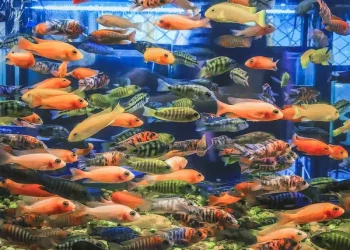The Australian lungfish, also known as the Queensland lungfish, is a unique freshwater fish species found in eastern Australia. These fish are known for their large size, long lifespan, and ability to breathe air using a primitive lung. In captivity, providing the proper tank size for a lungfish is crucial for their health and well-being. In this article, we will explore the ideal tank size for a lungfish and other important factors to consider when setting up their habitat.
Tank Size for Lungfish
The minimum recommended tank size for a single adult Australian lungfish is 150 gallons. However, larger tanks are always better as lungfish can grow up to 6 feet in length and can weigh up to 44 pounds. A 250-gallon tank or larger would be ideal for an adult lungfish, providing ample swimming space and room for them to grow.
It is important to note that lungfish are very active fish and require ample space to swim and explore. Providing a cramped tank can lead to stress, stunted growth, and health problems. Therefore, it is recommended to provide as large a tank as possible within your available space and budget.
Tank Setup for Lungfish
When setting up a tank for a lungfish, it is important to consider their natural habitat. Australian lungfish are found in slow-moving or stagnant freshwater environments with sandy or muddy bottoms. Therefore, providing a similar environment in the tank is important for their health and well-being.
A sandy or muddy substrate should be provided at the bottom of the tank. This will allow the lungfish to burrow and forage for food. Large rocks and driftwood can also be added to the tank to create hiding places and provide visual barriers.
The water temperature should be maintained between 70-80°F, and the pH should be kept between 6.5-8.0. A filtration system capable of handling the size of the tank should be installed to keep the water clean and free of harmful toxins.
Feeding Lungfish
Lungfish are primarily carnivorous and feed on a variety of prey, including small fish, crustaceans, and insects. In captivity, a well-rounded diet consisting of frozen or live foods such as shrimp, krill, and earthworms should be provided. Vegetables such as spinach, zucchini, and peas can also be added to their diet.
It is important to feed lungfish appropriately sized meals. Overfeeding can lead to obesity, digestive issues, and poor water quality. Adult lungfish should be fed once or twice a week, and any uneaten food should be removed from the tank to prevent water quality issues.
Providing a proper tank size for an Australian lungfish is crucial for their health and well-being. A minimum tank size of 150 gallons is recommended for a single adult lungfish, but larger tanks are always better. When setting up a tank, it is important to consider their natural habitat, provide ample space for swimming and exploring, and maintain appropriate water conditions. By following these guidelines and providing a well-rounded diet, lungfish can thrive in captivity and live a long and healthy life.


























